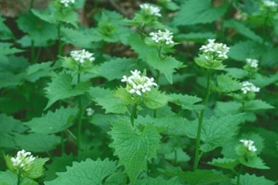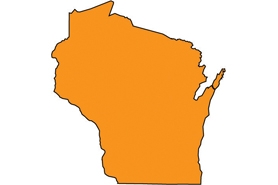Garlic mustard
(Alliaria petiolata)
Herbaceous biennial with stems 2-4’ tall. First-year plants form a basal rosette that remains green through the winter. Second-year plants produce one to several flowering contains.
Other names for this plant include:
- Common names: mustard root, garlic root, garlic-wort
- Scientific names: Alliaria officinalis; Alliaria alliaria; Arabis petiolata
Classification in Wisconsin: Restricted
- Ecological Threat
-
- It Invades high-quality upland, floodplain forests, savannas, and disturbed areas, such as yards and roadsides. It is sometimes found in full sun, though most often grows in sizes with some shade, and does not do well in acidic soils.
- Native herbaceous cover has been shown to decline at sites invaded by garlic mustard.
- Garlic mustard exudes antifungal chemicals into the soil that disrupt associations between mycorrhizal fungi and native plants, suppressing native plant growth.
- Identification
-
Leaves: First-year plants have basal leaves that are dark green, heart or kidney-shaped, with scalloped edges and wrinkled appearance. On second-year plants, stem leaves on flowering plants are alternate, triangular, with large teeth and up to 2-3” across. Leaves and stems smell like garlic when crushed.
Flowers: Small, white, 4-petaled, and abundant. Blooms throughout the spring.
Fruits & seeds: Seed pods are long (1-2 ½)”, slender capsules (siliques) green in color, drying to pale brown. Inside, seeds are small, shiny black and arranged in a single row. Plants can be recognized in late summer and fall with dry, papery brown, erect seedpods atop dead stalks. Seeds remain viable in the soil for at least seven years.
Roots: White, slender taproot, “S”-shaped at the top. It will re-sprout from the root crown if only the top of the plant is removed.
Similar species: Several native white-flowered plants, the toothworts (Dentaria spp.) and sweet cicely (Osmorhiza claytonii), bloom at about the same time as garlic mustard and may be mistaken for it. The leaves of native violets (Viola spp.) and the non-native creeping Charlie (Glechoma hederaea) may be mistaken for first-year garlic mustard plants, but they will not have a garlic odor when crushed.
- Control
-
Mechanical: Hand pulls in early spring before seed set. If plants are flowering, place them in plastic bags for trash disposal or burn. Cut plants at their base just after the flower stalks have elongated but before any flowers have opened; they may have to cut more than once during a growing season. Place pulled/cut plants in plastic bags for trash disposal. Use controlled burns in the fall or early spring.
Chemical: Foliar applications of glyphosate in early spring or late fall when native plants are dormant.
For more information on control techniques, visit the Garlic Mustard factsheet [exit DNR] by the University of Wisconsin-Extension.
- Resources
- Sources for content:
- Czarapata, Elizabeth; Invasive Plants of the Upper Midwest: an illustrated guide to their identification and control. The University of Wisconsin Press. 2005. Pg. 46-52
- Fewless, Gary. Herbarium, Cofrin Center for Biodiversity, UW-Green Bay. Invasive Plants of Wisconsin. Alliaria petiolata [exit DNR].
- Rowe, Pamela and Jil M. Swearingen. Plant Conservation Alliance, Alien Plant Working Group. Least Wanted: Garlic mustard [exit DNR]. Last updated in June 2005.


